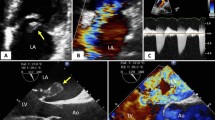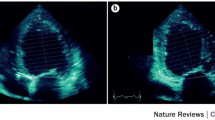Abstract
The development of interventional cardiology has changed the management of cardiovascular heart diseases. Interventional cardiology procedures require great accuracy and, as a result, imaging techniques play a significant role in confirming diagnosis, etiologic work-up, complication screening, and prognostic assessment. Echocardiography, with advancements such as three-dimensional imaging and tissue Doppler, is the most useful imaging technique because it is safer, faster, and less expensive than MRI or CT. This review article provides a comprehensive overview of the use of imaging techniques and their implication for interventional procedures.
Similar content being viewed by others
References and Recommended Reading
Naqvi TZ: Recent advances in echocardiography. Expert Rev Cardiovasc Ther 2004, 2:89–96.
Bonow RO, Carabello BA, Kanu C, et al.: ACC/AHA 2006 guidelines for the management of patients with valvular heart disease: A report of the American College of Cardiology/American Heart Association Task Force on Practice Guidelines (writing committee to revise the 1998 Guidelines for the Management of Patients With Valvular Heart Disease): developed in collaboration with the Society of Cardiovascular Anesthesiologist: endorsed by the Society for Cardiovascular Angiography and Interventions and the Society of Thoracic Surgeons. Circulation 2006, 114:e84–e231.
Wilkins GT, Weyman AE, Abascal VM, et al.: Percutaneous balloon dilatation of the mitral valve: an analysis of echocardiographic variables related to outcome and the mechanism of dilatation. Br Heart J 1988, 60:299–308.
Palacios IF, Sanchez PL, Harrell LC, et al.: Which patients benefit from percutaneous mitral balloon valvuloplasty? Prevalvuloplasty and postvalvuloplasty variables that predict long-term outcome. Circulation 2002, 105:1465–1471.
Kang DH, Park SW, Song JK, et al.: Long-term clinical and echocardiographic outcome of percutaneous mitral valvuloplasty: randomized comparison of Inoue and double-balloon techniques. J Am Coll Cardiol 2000, 35:169–175.
Song H, Kang DH, Kim JH, et al.: Percutaneous mitral valvuloplasty versus surgical treatment in mitral stenosis with severe tricuspid regurgitation. Circulation 2007, 116(11 Suppl):I246–I250.
De Agustin JA, Nanda NC, Gill EA, et al.: The use of three-dimensional echocardiography for the evaluation of and treatment of mitral stenosis. Cardiol Clin 2007, 25:311–318.
Sugeng L, Coon P, Weinert L, et al.: Use of real time three-dimensional transthoracic echocardiography in the evaluation of the mitral valve disease. J Am Soc Echocardiogr 2006, 19:413–420.
Zamorano J, Cordeiro P, Sugeng L, et al.: Real-time threedimensional echocardiography for rheumatic mitral valve stenosis evaluation: an accurate and novel approach. J Am Coll Cardiol 2004, 43:2091–2096.
Zamorano J, Pérez de Isla L, Sugeng L, et al.: Non-invasive assessment of mitral valve area during percutaneous balloon mitral valvuloplasty: role of real-time 3D echocardiography. Eur Heart J 2004, 25:2086–2091.
McCrindle BW: Independent predictors of immediate results of percutaneous balloon aortic valvotomy in children. Valvuloplasty and Angioplasty of Congenital Anomalies (VACA) Registry Investigators. Am J Cardiol 1996, 77:286–293.
Cribier A, Eltchaninoff H, Bash A, et al.: Percutaneous transcatheter implantation of an aortic valve prosthesis for calcific aortic stenosis: first human case description. Circulation 2002, 106:3006–3008.
Cribier A, Eltchaninoff H, Tron C, et al.: Treatment of calcific aortic stenosis with the percutaneous heart valve: mid-term follow-up from the initial feasibility studies: the French experience. J Am Coll Cardiol 2006, 47:1214–1223.
Webb JG, Chandavimol M, Thompson CR, et al.: Percutaneous aortic valve implantation retrograde from the femoral artery. Circulation 2006, 113:842–850.
Grube E, Schuler G, Buellesfeld L, et al.: Percutaneous aortic valve replacement for severe aortic stenosis in high-risk patients using the second- and current third-generation self-expanding CoreValve prosthesis: device success and 30-day clinical outcome. J Am Coll Cardiol 2007, 50:69–76.
Grube E, Laborde JC, Gerckens U, et al.: Percutaneous implantation of the CoreValve self-expanding valve prosthesis in high-risk patients with aortic valve disease: the Siegburg first-in-man study. Circulation 2006, 114:1616–1624.
Gutierrez-Chico JL, Zamorano JL, Prieto-Moriche E, et al.: Real-time three-dimensional echocardiography in aortic stenosis: a novel, simple and reliable method to improve accuracy in area calculation. Eur Heart J 2008, 29:1296–1306.
Feldman T, Wasserman HS, Herrmann HC, et al.: Percutaneous mitral valve repair using the edge-to-edge technique: six-month results of the EVEREST phase I clinical trial. J Am Coll Cardiol 2005, 46:2134–2140.
Shapira Y, Vaturi M, Weisenberg DE, et al.: Impact of intraoperative transesophageal echocardiography in patients undergoing valve replacement. Ann Thorac Surg 2004, 78:579–583.
Webb JG, Pate GE, Munt BI: Percutaneous closure of an aortic prosthetic paravalvular leak with an Amplatzer duct occluder. Catheter Cardiovasc Interv 2005, 65:69–72.
Pate GE, Al Zubaidi A, Chandavimol M, et al.: Percutaneous closure of prosthetic paravalvular leaks: case series and review. Catheter Cardiovasc Interv 2006, 68:528–533.
Marie Valente A, Rhodes JF: Current indications and contraindications for transcatheter atrial septal defect and patent foramen ovale device closure. Am Heart J 2007, 153:81–84.
Masura J, Gavora P, Podnar T: Long-term outcome of transcatheter secundum-type atrial septal defect closure using Amplatzer septal occluders. J Am Coll Cardiol 2005, 45:505.
Rigatelli G, Cardaioli P, Braggion G, et al.: Transesophageal echocardiography and intracardiac echocardiography differently predict potential technical challenges or failures of interatrial shunts catheter-based closure. J Interv Cardiol 2007, 20:77–81.
Mehmood F, Vengala S, Nanda NC, et al.: Usefulness of live three-dimensional transthoracic echocardiography in the characterization of atrial septal defects in adults. Echocardiography 2004, 21:707–713.
Pedra CA, Pontes SC Jr, Pedra SR, et al.: Percutaneous closure of postoperative and post-traumatic ventricular septal defects. J Invasive Cardiol 2007, 19:491–495.
Butera G, Carminati M, Chessa M, et al.: Transcatheter closure of perimembranous ventricular septal defects: early and long-term results. J Am Coll Cardiol 2007, 50:1189–1195.
Slavin L, Tobis JM, Rangarajan K, et al.: Five-year experience with percutaneous closure of patent foramen ovale. Am J Cardiol 2007, 99:1316–1320.
Slottow TL, Steinberg DH, Waksman R: Overview of the 2007 Food and Drug Administration Circulatory System Devices Panel meeting on patent foramen ovale closure devices. Circulation 2007, 116:677–682.
Di Tullio MR, Sacco RL, Sciacca RR, et al.: Patent foramen ovale and the risk of ischemic stroke in a multiethnic population. J Am Coll Cardiol 2007, 49:797–802.
Galal MO: Advantages and disadvantages of coils for transcatheter closure of patent ductus arteriosus. J Interv Cardiol 2003, 16:157.
Tzifa A, Ewert P, Brzezinska-Rajszys G, et al.: Covered Cheatham-platinum stents for aortic coarctation: early and intermediate-term results. J Am Coll Cardiol 2006, 47:1457–1463.
Haissaguerre M, Jais P, Shah DC, et al.: Electrophysiological end point for catheter ablation of atrial fibrillation initiated from multiple pulmonary venous foci. Circulation 2000, 101:1409–1417.
Wazni OM, Tsao HM, Chen SA, et al.: Cardiovascular imaging in the management of atrial fibrillation. J Am Coll Cardiol 2006, 48:2077–2084.
Cooper LT, Baughman KL, Feldman AM, et al.: The role of endomyocardial biopsy in the management of cardiovascular disease: a scientific statement from the American Heart Association, the American College of Cardiology, and the European Society of Cardiology. Endorsed by the Heart Failure Society of America and the Heart Failure Association of the European Society of Cardiology. Circulation 2007, 116:2216–2233.
Aqel RA, Hage FG, Cogar B, et al.: Transthoracic echocardiography guided procedures in the catheterization laboratory. Echocardiography 2007, 24:1000–1007.
Faber L, Seggewiss H, Welge D, et al.: Echo-guided percutaneous septal ablation for symptomatic hypertrophic obstructive cardiomyopathy: 7 years of experience. Eur J Echocardiogr 2004, 5:347–355.
Author information
Authors and Affiliations
Corresponding author
Rights and permissions
About this article
Cite this article
Vivas, D., Pérez de Isla, L. & Zamorano, J. Using echocardiography to guide interventional procedures. curr cardiovasc imaging rep 1, 9–15 (2008). https://doi.org/10.1007/s12410-008-0004-3
Published:
Issue Date:
DOI: https://doi.org/10.1007/s12410-008-0004-3




